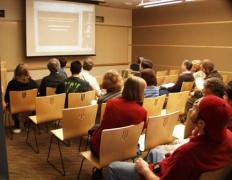Childhood Obesity Prevention
Childhood obesity prevention and treatment has become a priority in schools and communities at large all across the United States and many parts of the western world. This has been necessitated by worrisome childhood obesity statistics showing the prevalence of what has become indeed an epidemic. According to some sources obesity in general costs the American tax payer as much as $120 billion. This figure represents about 7 percent of the total health care bill and is likely to grow if current prevention and treatment measures prove to be ineffective or ill-designed.
 There are sound grounds for worry and need to prevent childhood obesity. Dangers of childhood obesity are many. Obesity in both the young and the old is associated with serious chronic diseases such as diabetes, hypertension, kidney disease and heart disease. Trends show that there is a strong link between childhood obesity and diabetes.
There are sound grounds for worry and need to prevent childhood obesity. Dangers of childhood obesity are many. Obesity in both the young and the old is associated with serious chronic diseases such as diabetes, hypertension, kidney disease and heart disease. Trends show that there is a strong link between childhood obesity and diabetes.
This is particularly the case with type 2 diabetes which is now very common amongst children and adolescents. Credible pediatric obesity facts show that obesity gives a ten times increase in diabetes, 2 to 3 times increased risk to develop cardiovascular disease, 3 to 10 times increased risk of developing osteoarthritis. This a joint disorder associated with stiffness and pain in joints.
Childhood obesity prevention is an exciting opportunity for parents, communities and authorities such as governments to bring about lasting change in the lives of kids. Prevention of childhood obesity in America and certainly in many other countries can be viewed as a two pronged strategy involving the individual and the community.
At an individual level experts contend that children may be encouraged to develop healthy eating habits at home and at school with parents playing an important role by introducing healthy eating at home. Dieticians believe that our kids learn to eat healthy when they see us preparing healthy meals and being generally health conscious.
Prevention of childhood obesity at the individual level will also involve encouraging kids to exercise. This is mainly achieved when kids abandon a sedentary lifestyle which is an important cause of childhood obesity in many developed countries. Awareness can be raised for kids to be more active both at school and at home and spend less time behind the computer or watching television.
The second approach to pediatric obesity prevention programs is community level interventions. Communities play an extremely important role in preventing obesity in children. Whilst it is understood that the effectiveness of obesity prevention programs is still to be fully appreciated due to limited data, there is certainly value in combined efforts in dealing with any form of epidemic.
Community efforts at preventing childhood obesity will be aimed at helping children stay active, encouraging kids to eat healthy and promoting healthy choices at a community level. As a parent or caregiver you may easily take lessons and tips from this article and apply them in your own situation in the community.
Community efforts at combating childhood obesity may also involve lobbying and advocacy work that may lead in the enforcement of new legislation aimed at protecting children to obesity causes. Legislative prevention methods will include, for example, getting policies implemented regulating the number of fast-food outlets in your location.
This may also include how stores and groceries advertise certain unhealthy food stuffs targeted at children. Childhood obesity prevention tackled at the community level will also include a campaign working with school boards to change school lunch contents, change deliverable sof vending machines often located in school premises and other places frequented by our kids.
 There are vast opportunities and areas to be covered in as far as childhood obesity prevention programs are concerned. There is yet a lot of room for modifications which are beneficial to this cause to be implemented in communities that our children live.
There are vast opportunities and areas to be covered in as far as childhood obesity prevention programs are concerned. There is yet a lot of room for modifications which are beneficial to this cause to be implemented in communities that our children live.
It is apparent that not everyone who matters in this war against childhood obesity is aware of what we are aware of as far as the epidemic is concerned. In fact many important key persons in government and local authorities may require awareness workshops and seminars on statistical data and childhood obesity facts. This may easily lead to some changes at policy level that will be beneficial to our cause of preventing childhood obesity.
The following are some quick take home points of what we can do as communities in preventing obesity amongst our kids;
1. Transform abandoned infrastructure such as rail-roads into walk areas
2. Create more sidewalks and reduce opportunities to drive.
3. Create more activity parks with provision for bike rides and so on in our communities.
4. More facilities such as schools and amusement parks in future development plans within walking distance.
5. Create room for establishing a local farmers market that will supply your community with a lot of greens i.e fruits and veggies including other healthy foods
Farmers market gives easy access to lots of fruits and veggies for the whole community. Learn in detail about vegetable nutrition facts as well as fruit nutrition.
Parents, caregivers, community, members and policy makers will need to recognize that there is essentially no magic bullet against obesity. It is really a matter of balancing the energy in our kids. Whenever there is more energy generated from the food that our kids eat and less opportunities to spend it then weight gain will swiftly follow. This calls for all involved to be constantly evaluating the different strategies and interventions in pediatric obesity prevention.
Childhood Obesity Prevention Programs - KidsWalk-to-School
 Started by the CDC in the United States the KidsWalk-to-School program is beneficial for obesity prevention amongst children. This is achieved by encouraging groups of children to walk or bicycle to school in the company of an adult.
Started by the CDC in the United States the KidsWalk-to-School program is beneficial for obesity prevention amongst children. This is achieved by encouraging groups of children to walk or bicycle to school in the company of an adult.
This increases activity amongst children and erodes a sedentary lifestyle which is key to the growth of obesity in communities. This program is a community program which will involve all members and stakeholders in local communities in the United States. More information on this program can be found from the CDC website. (picture: CDC website)
Childhood Obesity Prevention And Treatment
Treatment of childhood obesity is less preferred than prevention. As they say prevention is better that cure. This is the reason behind strong and growing prevention interventions mentioned above. However, still in many cases medical treatment will be required for some children who are overweight or obese. This involves pharmacological drugs which are administered by a specialist doctor. The age of your child will be all important in considering what treatment is suitable.
In some cases weight-loss surgery will be required to immediately avoid certain complications associated with obesity. In some cases treatment will be aimed at weight maintenance rather than weight loss especially for kids under 7 years of age. Eating healthy particular in the context of lifestyle modifications is the first line of treatment. This way many kids lose weight significantly without ever requiring any of the other types of treatment available.


